 When Positioning Systems started in 1998 my intention was to help businesses discover their unique and valuable position. For 20 years I helped business create messages to differentiate from their competition. Jack Trout and Al Ries’ classic marketing book Positioning: The Battle for Your Mind provided this impetus. A classic positioning example was 7-Up’s, The Uncola!
When Positioning Systems started in 1998 my intention was to help businesses discover their unique and valuable position. For 20 years I helped business create messages to differentiate from their competition. Jack Trout and Al Ries’ classic marketing book Positioning: The Battle for Your Mind provided this impetus. A classic positioning example was 7-Up’s, The Uncola!
If you’re still using that framework to define your strategy, it’s not exactly you need to be. As Shannon Susko points out in 3HAG WAY: The Strategic Execution System that ensures your strategy is not a Wild-Ass-Guess! you don’t need to be the best, you just need to be unique and different. To do this you need to identify 3 – 5 key differentiating activities. These differentiating activities need to be integrated. Integrated means your competition may copy one, maybe two, but to copy three or more will be extremely difficult.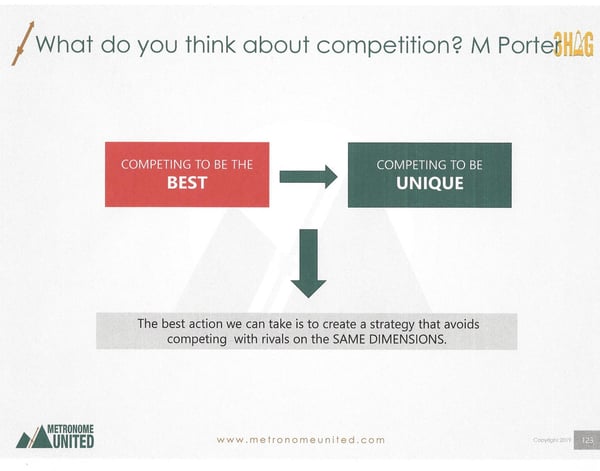
According to Michael Porter’s research, there are three generally accepted ways to create a differentiated strategic position:
- Serve the broad needs of a few customers.
- Serve some needs of many customers.
- Serve many needs for many customers in a super-specific market.
Key Attribution Framework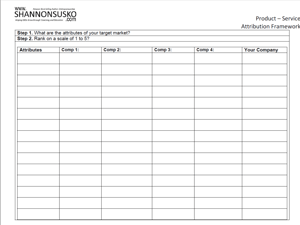
How do we go about finding these differentiating activities?
With your leadership team use the Key Attribution Framework (shown here) to explore the key attributes of the market you company is playing in.
Break into teams of 3-4 to discuss six to eight key attributes in the market your company is playing. Fill these in on the left-hand side in the column marked “Attributes.”
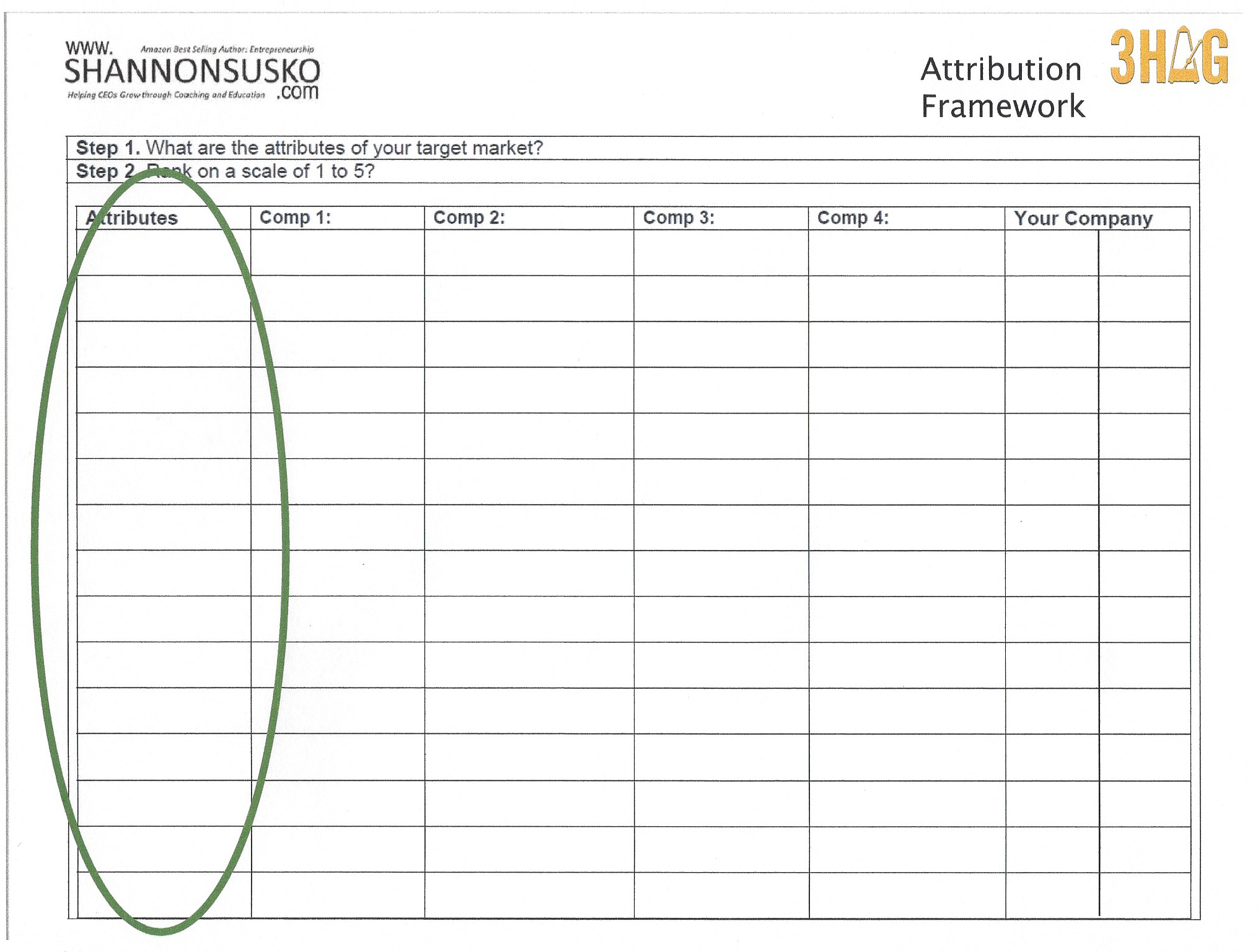 Have each person come up with 3 attributes. Then create a short list of attributes to measure.
Have each person come up with 3 attributes. Then create a short list of attributes to measure.
Find Your White Space
As a group, go to the column labeled “Your Company” and rank on a scale of 1 to 5 how well your company serves each of these attributes—one by one. Be as honest and realistic as possible. You cannot be good at them all. Write those attributes you are best to worst from left to right across the bottom.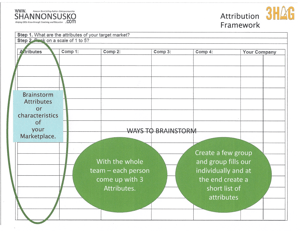
Now identify three or four competitors. Put the name of a competitor in each of the columns labeled “Comp 1,” “Comp 2,” and so on. Do the same ranking for up to four of your competitors.
Once you have all the competitors ranked, as well as your own company, go to the second page and write the attributes across the bottom axis in the order of best to worst ranking based on your company’s rankings. In the Paradata example in the book, 24/7 Service was the first attribute across the bottom axis, and then Reseller Program, Setup, Multicurrency, and so on.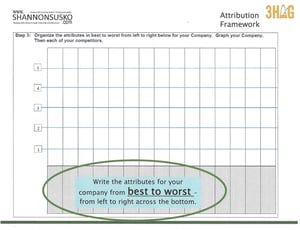
Once each group has written the attributes across the bottom axis, plot the line for your company and then for each of your competitors. See Paradata’s example.
Once all the groups have mapped the Attribution Framework, have each group share their graph and how they came up with the results. As a group, decide on 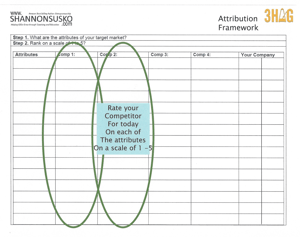 what the 6–8 attributes will be for the company. And then have a volunteer collate the input into one graph for the next meeting and post it on the wall of your meeting room.
what the 6–8 attributes will be for the company. And then have a volunteer collate the input into one graph for the next meeting and post it on the wall of your meeting room.
Based on the results, Paradata (example from the book) saw the areas in which we could excel relative to competitors: setting up clients, working in multiple currencies, offering 24/7 service, and providing an excellent reseller program. 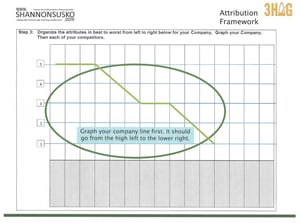 Through this analysis they decided to put less emphasis on providing merchant accounts and point-of-sale integration.
Through this analysis they decided to put less emphasis on providing merchant accounts and point-of-sale integration.
As you can see on the top left of the graph, Paradata had this white space all to themselves.
One important realization often arises during this analysis. Your team members may not know all that much about their competitors.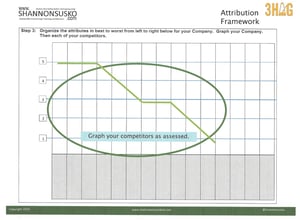
In successful high-growth companies everyone on the leadership team should be a market expert.
Remember Porter’s definition of strategy—creating a unique and valuable position in the marketplace—you’re not competing directly against your competitors. You are competing to be unique in the marketplace. Being unique in your marketplace requires a sophisticated understanding of what your market looks like. Members of the leadership team must be market experts who continually study to keep their knowledge up to date.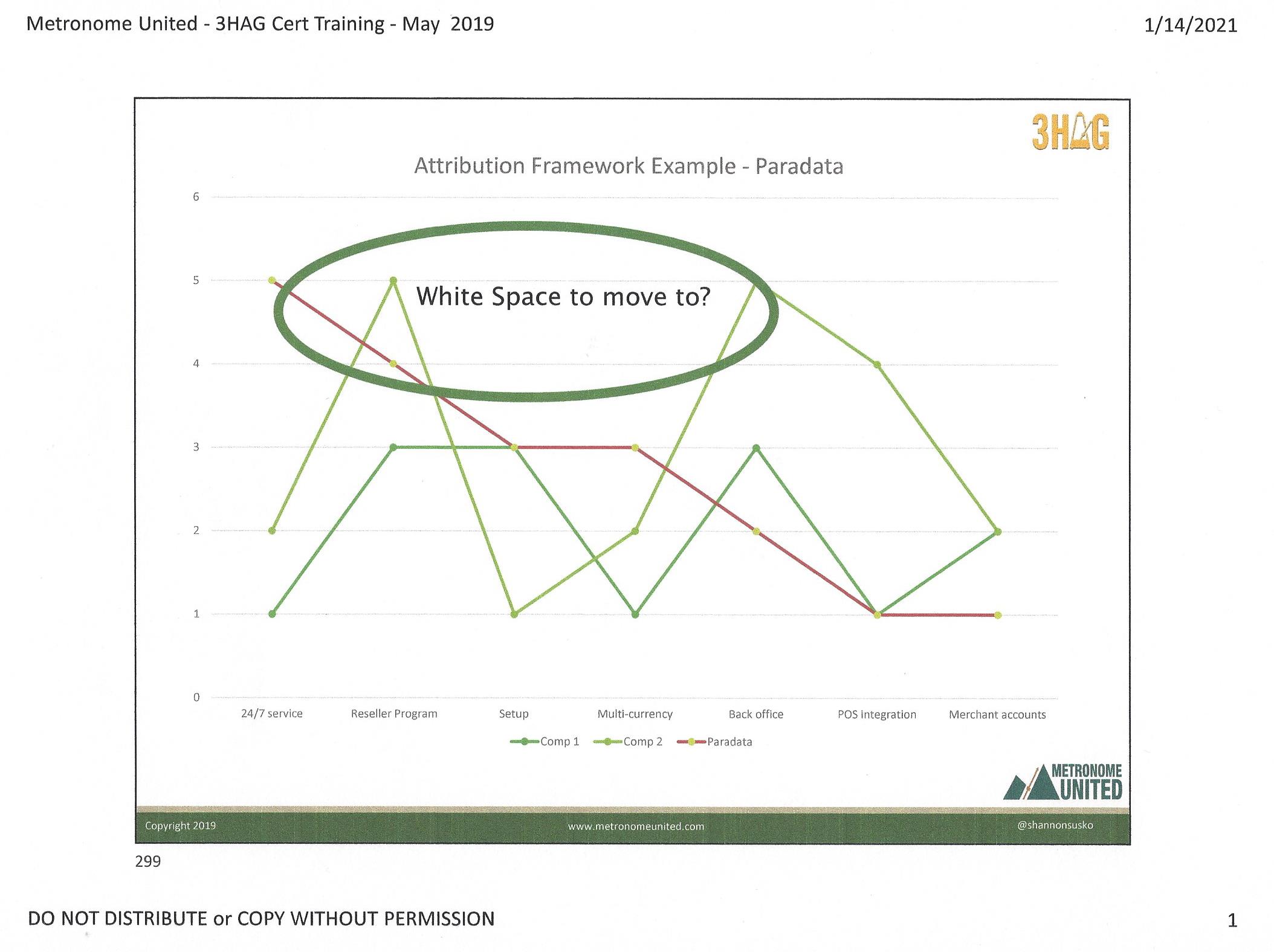
After completing their first Attribution Framework, companies usually step back and say one of two things. Some say, “This shows that we’re in the right position. Let’s keep the momentum going! Let’s keep evolving to remain unique and valuable!”
More frequently it sounds like this: “Wow! We look like everyone else—and look at all that available white space! We need to evolve our strategy!”
Having completed your Attribution Framework, you’ve probably concluded you’re not quite where you want to be.
Time to decide where you really do want to be.
In the table you completed, add a new column to describe how you want your company to meet the attributes of the market.
Decide where you will serve the Core Customer well and where you will not. Add this aspirational line to your Attribution Framework: this is your future unique and valuable position!
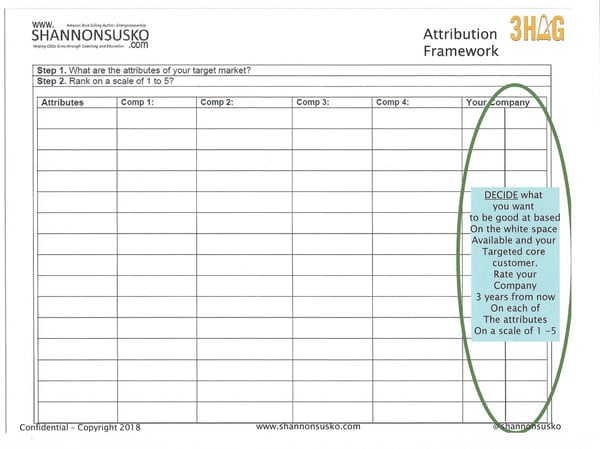
The last step is to have a team discussion based on the white space available, what your company should decide to do, and what they should decide not to do.
Paradata (Example) decided to offer 24/7 phone service, a white label Reseller Program, merchant setup in an hour or less, and multicurrency.
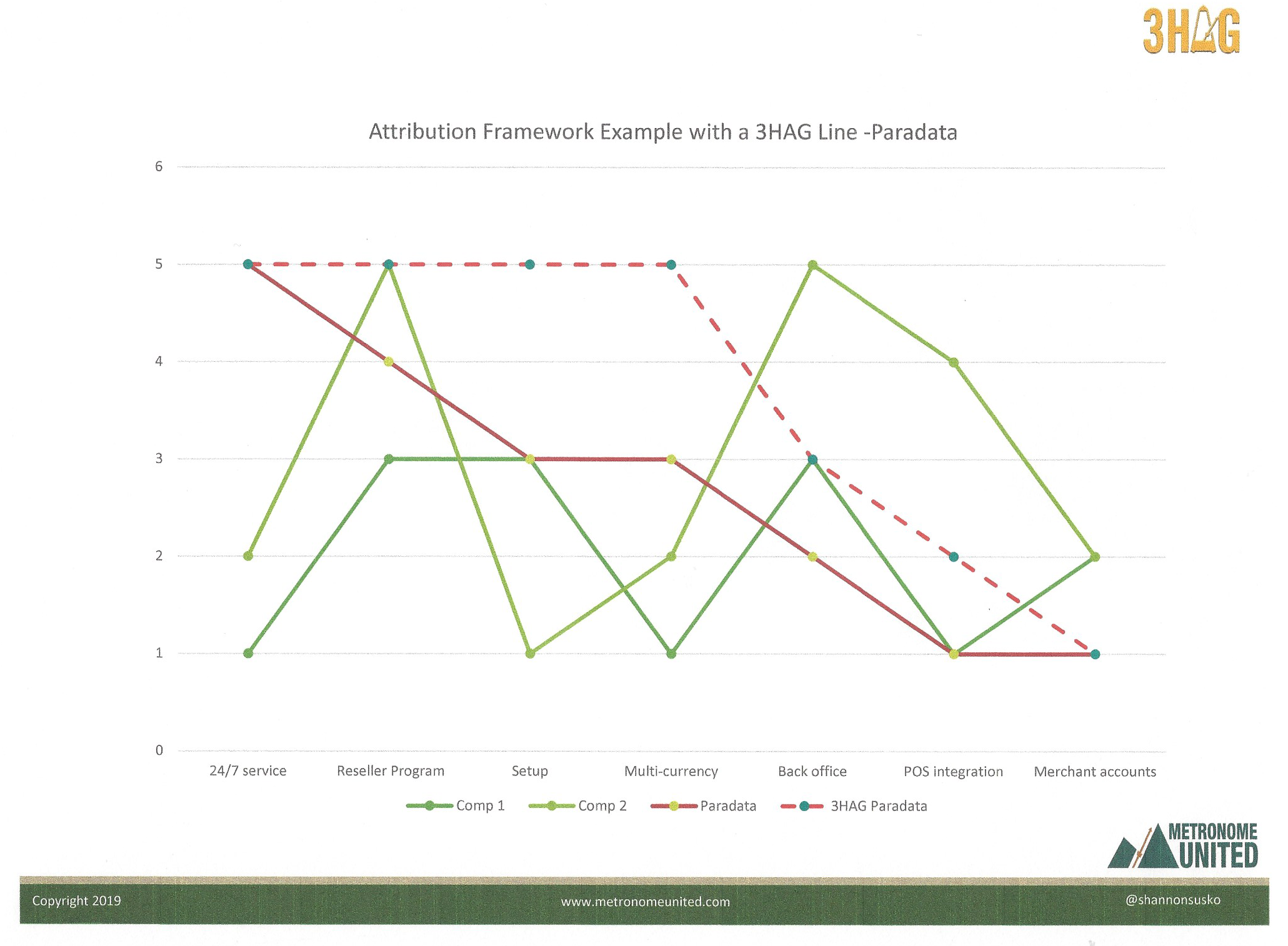 In the graph, Paradata’s red, dotted 3HAG Line shows what they decided to move into a unique and valuable position.
In the graph, Paradata’s red, dotted 3HAG Line shows what they decided to move into a unique and valuable position.
This was aspirational. They knew they’d have to work hard to implement it keeping a close eye on the market and their company.
Paradata identified the differentiating actions based on the white space identified in the Attribution Framework.
When building this with your team you may come up with between three and eight actions. Best practice is to whittle this down to three to five to keep focus and really carve out your position.
Strategy Decisions are all about top line revenue growth! Contact us today to schedule a free exploratory meeting to get started now!
Growth demands Strategic Discipline.
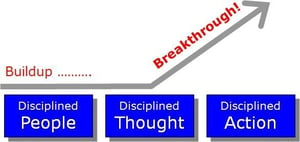 To build an enduring great organization, requires disciplined people, disciplined thought, disciplined action, to produce superior results, and make a distinctive impact in the world.
To build an enduring great organization, requires disciplined people, disciplined thought, disciplined action, to produce superior results, and make a distinctive impact in the world.
Discipline sustains momentum, over a long period of time, laying the foundations for lasting endurance.
A winning habit starts with 3 Strategic Disciplines: Priority, Metrics and Meeting Rhythms. -2.jpg?width=300&name=3%20Disciplines%20of%20Execution%20(Strategic%20Discipline)-2.jpg) Forecasting, accountability, individual, and team performance improve dramatically.
Forecasting, accountability, individual, and team performance improve dramatically.
Meeting Rhythms achieve a disciplined focus on performance metrics to drive growth.
Let Positioning Systems help your business achieve these outcomes on the Four most Important Decisions your business faces:
|
DECISION |
RESULT/OUTCOME |
|
PEOPLE |
|
|
STRATEGY |
|
|
EXECUTION |
|
|
CASH |
|
Positioning Systems helps mid-sized ($5M - $250M) business Scale-UP. We align your business to focus on Your One Thing! Contact dwick@positioningsystems.com to Scale Up your business! Take our Four Decisions Needs Assessment to discover how your business measures against other Scaled Up companies. We’ll contact you.
 NEXT BLOG – Five Temptations of a CEO
NEXT BLOG – Five Temptations of a CEO
Have you ever read a great book, only to return to it and realize you’d failed to remember the principles in it? I recently reread two books, The Five Temptations of a CEO and The Four Obsessions of a CEO by Patrick Lencioni. Next blog reminders from Five Temptations of a CEO.






.jpeg?width=150&height=135&name=Hand%20with%20marker%20writing%20the%20question%20Whats%20Next_%20(1).jpeg)

